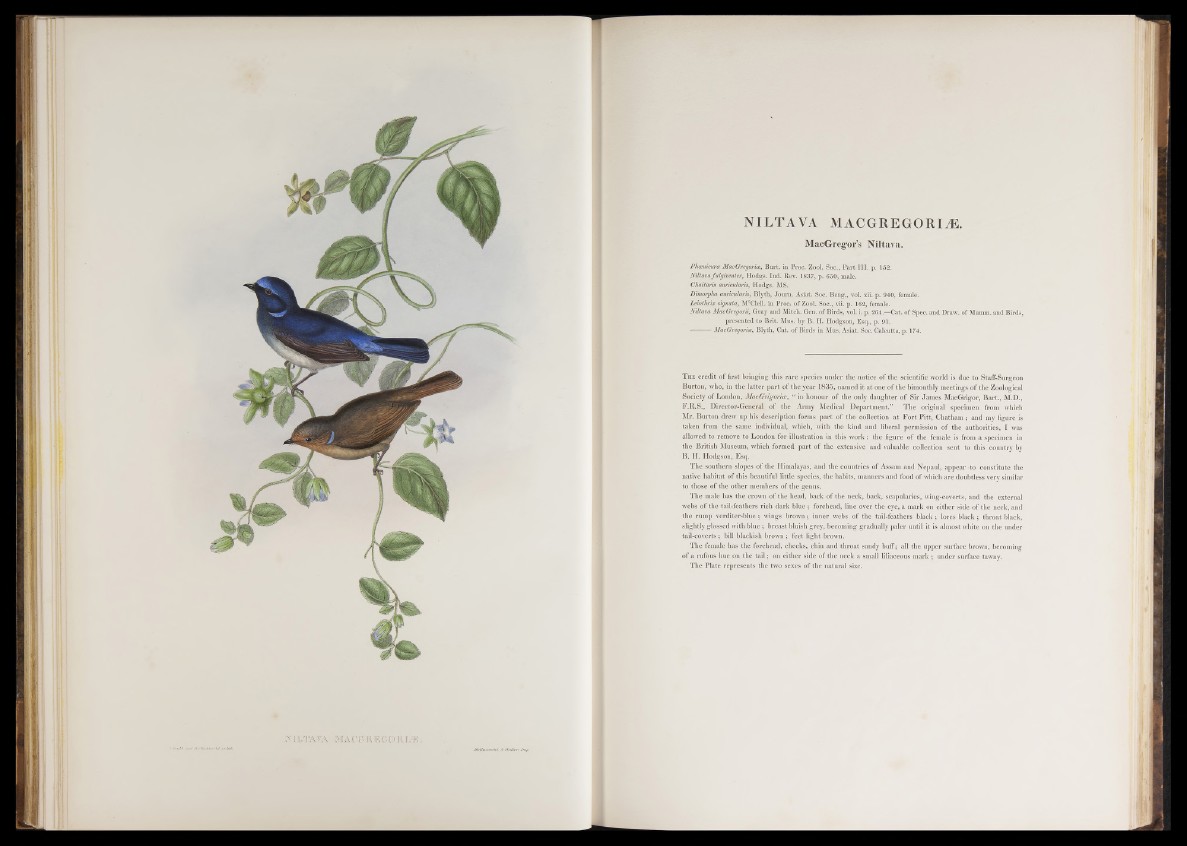
NILTAVA MACGREGORIiE.
MacGregor's Niltava.
Phcenicura MacGregorue, Burt, in Proc. Zool. Soc., Part I II. p. 152.
Niltava fulgiventer, Hodgs. Ind. Rev. 1837, p. 650, male.
Chaitaris auricularis, Hodgs. MS.
Dimorpha auricularis, Blyth, Journ. Asiat. Soc. Beng., vol. xii. p. 940, female.
Leiothrix signata, McClell. in Proc. of Zool. Soc., vii. p. 162, female.
Niltava MacGregorii, Gray and Mitch. Gen. of Birds, vol. i. p. 264.—Cat. of Spec, and Draw, of Mamm. and Birds,
presented to Brit. Mus. by B. H. Hodgson, Esq., p. 91.
MacGregorice, Blyth, Cat. of Birds in Mus. Asiat. Soc. Calcutta, p. 174.
T h e credit of first bringing this rare species under the notice of the scientific world is due to StafF-Surgeon
Burton, who, in the latter part of the year 1835, named it a t one o f the bimonthly meetings of the Zoological
Society of London, MacGrigorice, “ in honour of the only daughter of Sir James MacGrigor, Bart., M.D.,
F.R.S., Director-General of the Army Medical Department.?^ The original specimen from which
Mr. Burton drew up his description forms p art of the collection a t Fort Pitt, Chatham; and my figure is
taken from the same individual, which, with the kind and liberal permission o f the authorities, I was
allowed to remove to London for illustration in this w o rk : the figure of the female is from a specimen in
the British Museum, which formed p art o f the extensive and valuable collection sent to this country by
B. H. Hodgson, Esq.
The southern slopes o f the Himalayas, and the countries of Assam and Nepaul, appear -to constitute the
native habitat of this beautiful little species, the habits, manners and food o f which are doubtless very similar
to those of the other members o f the genus.
The male has the crown of the head, back of the neck, back, scapularies, wing-coverts, and the external
webs o f the tail-feathers rich dark blue ; forehead, line over the eye, a mark on either side o f the neck, and
the rump verditer-blue; wings brown; inner webs o f the tail-feathers b lack ; lores black; throat black,
slightly glossed with b lu e ; breast bluish grey, becoming gradually paler until it is almost white on the under
tail-coverts; bill blackish brown ; feet light brown.
The female has the forehead, cheeks, chin and throat sandy buff; all the upper surface brown, becoming
of a rufous hue on the ta il; on either side o f the neck a small liliaceous mark ; under surface tawny.
The Plate represents the two sexes of the natural size.